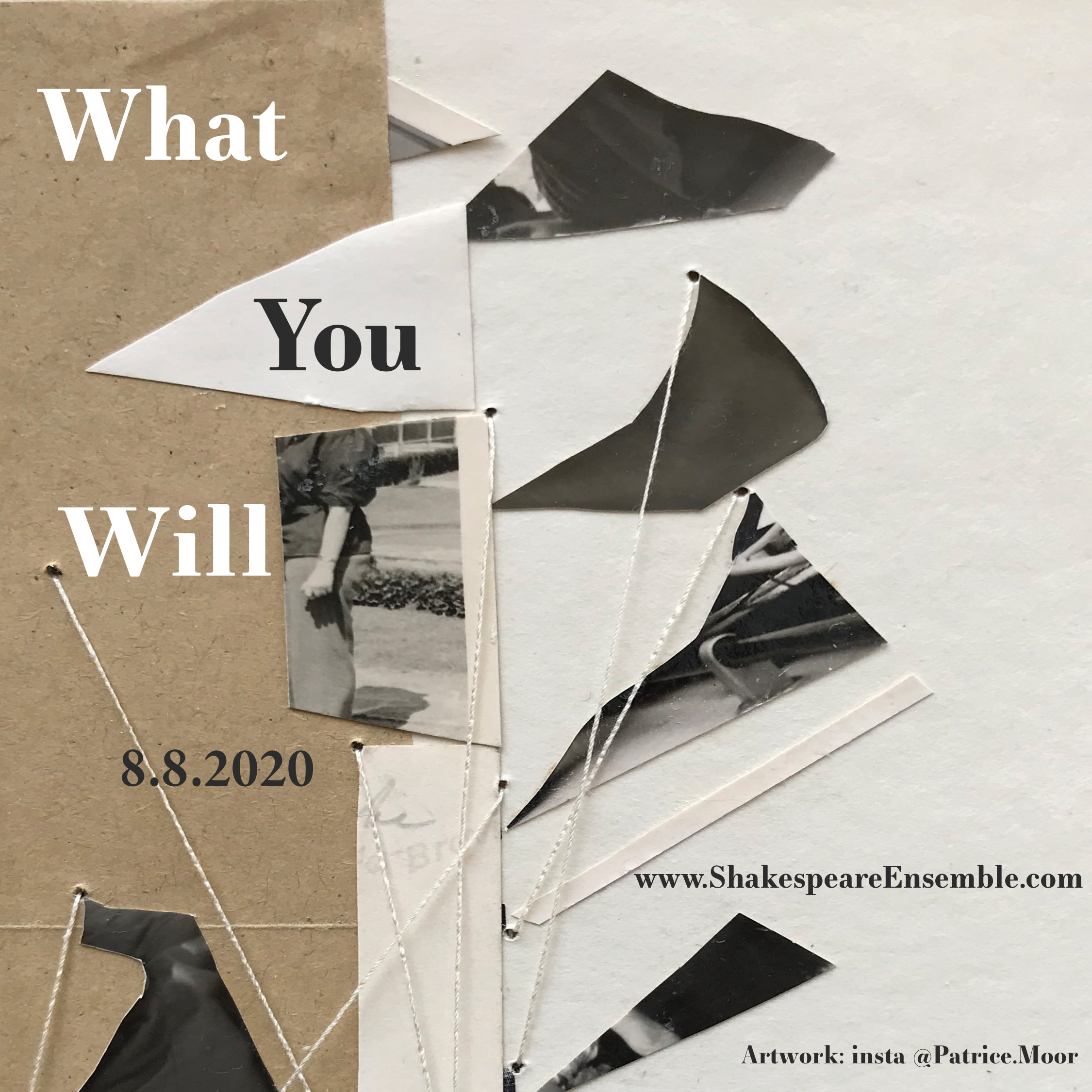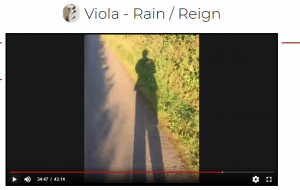
August 25, 2020, by Peter Kirwan
What You Will (The Shakespeare Ensemble) @ online
Of the Shakespeare events produced during lockdown, The Shakespeare Ensemble’s What You Will is one of the ones to make the most of the affordances of digital media. Eschewing entirely the need for linear narration, the original live event hosted no fewer than nine separate streams occurring simultaneously, creating a virtual promenade performance that allowed audiences to move freely between different streams and watch as much or as little of each as they liked. The initial concept is somewhat reminiscent of the RSC’s Midsummer Night’s Dreaming that I wrote about with Christie Carson in our book Shakespeare and the Digital World a few years back, but with less signposting to shape the narrative. This feels true to the experience of lockdown, with much more agency on the part of the individual performers in their different locations around the globe. Over on the (Re)Thinking Shakespeare blog, Gemma Allred has written a great discussion of the live event, which has now been re-released in an archived version to be re-experienced at length.
I should confess that I struggled with the live event. The What You Will website is constructed as a map, with options to switch between ‘locations’ at will; however, a lazy internet connection meant that I had quite long interruptions every time I tried to switch, and I seemed to keep landing in streams where there wasn’t much going on or where I struggled to hear what was happening. Promenade theatre works for me because of its spatial properties: the ability to move, to experience my own embodied interactions with an artwork, to adjust my viewing experience. As a live promenade experience wedded to my desk chair, the experience of clicking between several different pages and trying to work out what I was falling into was dispiritingly hard work and much too fragmentary, reinforcing my sense that the best promenade theatre depends on a certain amount of curation/navigation to help develop threads. In that sense, the archive version – which reproduces all nine strands in their full length – works much better in theory as it gives the audience member the time to curate their own experience, to rewind and rewatch and scaffold things for their own interest.
For the purposes of this review, I committed to watching a whole stream, focused around Em Thane’s Viola. Their stream begins with them looking into the camera, a towel around their head, then moving back into their bathroom and bringing the camera in with them. It’s a curiously intimate experience, watching Viola wash their face for several minutes, before they even say a word. As they start getting dressed, they begin playing with the ‘Make me a willow cabin’ speech, trying out each word in turn and exploring the sound of it, the repetition turning the speech into a strangely hypnotic piece of performance poetry which continues as Viola leaves the house and starts walking down a country lane. There’s something quietly thrilling about the location shoot, shots of tractors and stiles and open space contrasting with the very confined space of the bathroom where we first find them. And the pay off comes in the wonderful moment where, some ten minutes after they began speaking, where Viola is able to turn the camera towards the distant hills as they finally complete the line ‘Halloo your name to the reverberate hills’.
In some ways, the quieter moments are the most profound. Around halfway through, Viola sits down on a verge next to a fence and just spends some time looking at the camera, which is the first moment in which I had a sense of my own role as interlocutor. It’s a profoundly intimate moment, hearkening back to the spatial privilege I was granted earlier of sharing Viola’s bathroom, and as Viola leans on the bank and plays with pieces of grass, there’s a sense of closeness that Thane manages to make comfortable. I feel like they want something from me; I also feel like it’s okay for me not to respond, and to simply sit and listen to the grass grow and the sheep bleat. And then, suddenly, Viola picks up the camera and places it carefully down before walking off further down this quiet lane. Left alone, watching this stream from my own room in an area I’ve not left for five months, the sounds of the sheep and the light dappling the grassy verge is elegiac, sad. While on one level, I know that Viola is returning for me (they aren’t going to abandon their phone, presumably), I find myself experiencing conflicting feelings of abandonment and trust. Would they have carried us lovingly this far only to leave us? But on the other hand, do I really know them at all?
It’s only a few minutes until Viola returns, soaked, having taken a private moment (some wild swimming? A duck of their head into cold water to wake themselves up?). In silence, more or less, Viola picks up the camera and begins walking away, at times tilting the camera so that all we see is sky or hedgerows, and sometimes their face. At points during this walk, Viola stares for a long time into the camera and again the gaze is reassuring, intense but non-confrontational, showing us they are alert to our presence and sharing something with us, but not demanding more of us than that presence. Then at other times, the camera is turned back to the hedges, or onto Viola’s shadow in the low early evening summer light.
There’s a blip in Viola’s bandwidth as they return home, but the return to the bedroom initiates a fascinating little set of moments as suddenly they begin manoeuvring a set of props. At one point, they fill the entire screen with a bright yellow balloon, through which we can just make out her silhouette; at another, a flashing set of fairy lights projects a flickering shadow onto the ceiling. A close-up of an arrangement of bottles perhaps links to some of the other storylines such as Belch’s focus on addiction. Pasted onto the inside door of a wardrobe is an image of a statue of an elephant (The Elephant?), and then when Viola returns to the bathroom, they hold up their phone so that it is visible in the mirror, creating an infinite gallery of images of their face. The balloon repeatedly interrupts, continuing to block out the screen as if a makeshift fade to black. The opacity of the balloon is disconcerting after such a long time in such intimate close-up, self-consciously artisanal, but this is something that Viola seems to recognise too. Eventually they sit down, look us directly in the eye, and tell us – sadly, soberly – ‘It is too hard a knot for me to untie’. And the rest is silence and an unbroken gaze shared between Viola and the viewer.
I’m unclear why this segment is entitled ‘Rain/Reign’, or at least where ‘reign’ comes from (it’s not a word that I think appears in Twelfth Night at all, and if the homophone has meaning here then it is opaque). But as a mood piece inspired by Twelfth Night, it’s surprisingly effective. We begin with Viola in their own person, we move on a journey with them which results in them being drenched, and then – in the final movement of the piece – we see Viola experimenting with artifice, machinery, disguise and obscurity, finding something playful before abandoning it to return to honest expression. The overall mood is one of yearning, more than anything else – a formation of a mostly unspoken connection, a desire for an end to artifice, a need to share time and space with someone, even anyone. And that connection, importantly, needs to emerge from something unfiltered, rather than something constructed.
My choice to remain with Viola for the full 45 minutes of her stream is one that serves my own needs/interests in narrative and durational experience, and I felt rewarded for that patience; the temptation to skip away and go to see someone doing something in a more active way was present, and yet the peace and co-presence of the Viola stream were welcome, gentle. But there’s lots going on elsewhere. To take a snapshot: the Feste stream (performed by Hazel Askew of the superb Askew sisters) offers a soundtrack of accordion music and songs, performed calmly direct to camera; María de Abajo (Opportunism) offers some surprisingly experimental camera work through a limited iris; Colin Hurley’s Malvolio raves and chunters in the ‘Madness’ track. There are riches here for those with the time to watch all of the nine micro-performances through; pleasingly, too, the website design keeps the streams synchronised, so you can continue to look for connections between what was happening in real time. But even this focused time spent with a single actor was rewarding, thoughtful, carving out time to think and be, without necessarily needing to worry about untying knots.
No comments yet, fill out a comment to be the first


Leave a Reply